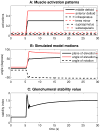A real-time, 3-D musculoskeletal model for dynamic simulation of arm movements
- PMID: 19272926
- PMCID: PMC2971671
- DOI: 10.1109/TBME.2008.2005946
A real-time, 3-D musculoskeletal model for dynamic simulation of arm movements
Abstract
Neuroprostheses can be used to restore movement of the upper limb in individuals with high-level spinal cord injury. Development and evaluation of command and control schemes for such devices typically require real-time, "patient-in-the-loop" experimentation. A real-time, 3-D, musculoskeletal model of the upper limb has been developed for use in a simulation environment to allow such testing to be carried out noninvasively. The model provides real-time feedback of human arm dynamics that can be displayed to the user in a virtual reality environment. The model has a 3-DOF glenohumeral joint as well as elbow flexion/extension and pronation/supination and contains 22 muscles of the shoulder and elbow divided into multiple elements. The model is able to run in real time on modest desktop hardware and demonstrates that a large-scale, 3-D model can be made to run in real time. This is a prerequisite for a real-time, whole-arm model that will form part of a dynamic arm simulator for use in the development, testing, and user training of neural prosthesis systems.
Figures




References
-
- Keith MW, Peckham PH, Thrope GB, Stroh KC, Smith B, Buckett JR, Kilgore KL, Jatich JW. Implantable functional neuromuscular stimulation in the tetraplegic hand. J Hand Surg [Am] 1989 May;14:524–530. - PubMed
-
- Bryden AM, Memberg WD, Crago PE. Electrically stimulated elbow extension in persons with c5/c6 tetraplegia: a functional and physiological evaluation. Arch Phys Med Rehabil. 2000 Jan;81:80–88. - PubMed
-
- Thorsen R, Spadone R, Ferrarin M. A pilot study of myoelectrically controlled fes of upper extremity. IEEE Trans Neural Syst Rehabil Eng. 2001 Jun;9:161–168. - PubMed
-
- Popovic MR, Popovic DB, Keller T. Neuroprostheses for grasping. Neurol Res. 2002 Jul;24:443–452. - PubMed
-
- Ragnarsson KT. Functional electrical stimulation after spinal cord injury: current use, therapeutic effects and future directions. Spinal Cord. 2007 Sep; - PubMed
Publication types
MeSH terms
Grants and funding
LinkOut - more resources
Full Text Sources
Other Literature Sources

